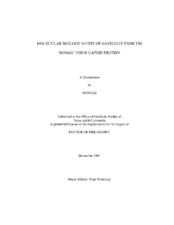| dc.description.abstract | Satellite panicum mosaic virus (SPMV) depends on its helper Panicum mosaic virus
(PMV) for replication and movement in host plants. The positive-sense single-stranded
genomic RNA of SPMV encodes a 17-kDa capsid protein (CP) to form 16-nm virions.
Previous studies showed that SPMV CP has multiple functions during infection
including encapsidation, symptom exacerbation, inhibiting the accumulation of SPMV
DIs, and facilitating systemic movement.
This dissertation confirms and extends the results of our previous reports with new
biological and biochemical evidence. For example, the dosage effect of SPMV CP on
symptom severity supports its function as a pathogenicity factor. Biological assays also
demonstrate compensatory effects of SPMV CP on virus mutants defective in systemic
movement. In addition, it is shown for the first time that SPMV CP is involved in cellto-
cell movement of SPMV RNA and associated with the cell wall and membranes, a
signature property of plant virus movement proteins. However, SPMV CP in the cytosol
exists exclusively as virions and is dispensable for symptom exacerbation. SPMV CP contains a distinctive N-terminal arginine-rich motif (N-ARM), which is
required for the in vitro binding of SPMV and PMV genomic RNAs by SPMV CP.
Mutations of this region impair all known functions of SPMV CP. Interestingly,
manipulation of the C-terminus of SPMV CP resulted in the same phenotypes as
alterations in the N-ARM except that this does not affect the RNA binding activity of
SPMV CP. Biological experiments demonstrate that virions are not required for the
properties of SPMV CP to facilitate local and systemic movement and inhibit the
accumulation of SPMV DIs, suggesting that SPMV CP and RNA form alternative
complexes for these purposes. This dissertation study reveals the nucleolar localization
of SPMV CP and its interaction with PMV CP in the form of virions.
The identification of distinct functional domains of SPMV CP and its complex
subcellular localization profile resulted in the proposal of a tentative model on how the
functions of SPMV CP are coordinated for a robust infection. This dissertation provides
a foundation for further understanding of the complex interactions among host plants,
helper viruses, and satellites. | en |


